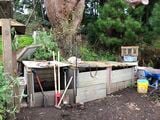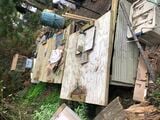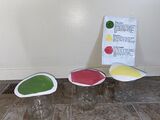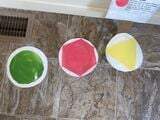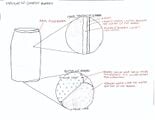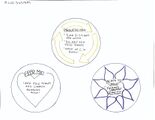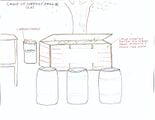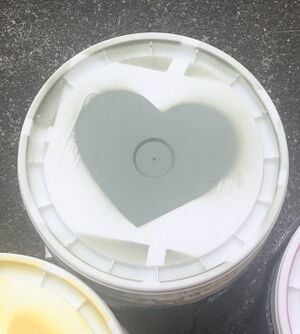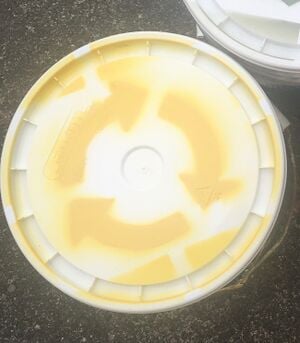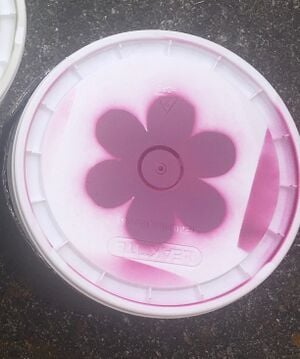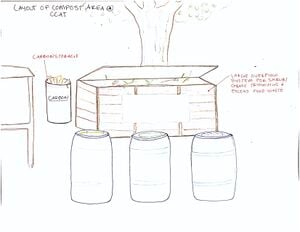
A community-sized composting system designed for The Community Center of Appropriate Technology (CCAT) at Cal Poly Humboldt in Arcata, CA. CCAT had a system in place that was not working for their desires and wanted to upgrade to a system that was more efficient and user-friendly. The design was developed to be self-serving and easy to use, with minimal labor. We developed different ideas, while prototyping to see what CCAT preferred and disliked. We settled on a 3 barrel system with rotating lids to have multiple batches of compost at one time, to keep a continuous rotation. As well as, a separate system in place for green waste made from the infrastructure of the previous composting system already in place. This system is 2 piles with slower output, to require less labor and attention. We designed informative signs and pamphlets to pair with our system, for optimal understanding and education.
Background[edit | edit source]
The Campus Center for Appropriate Technology (CCAT) was established at Cal Poly Humboldt (HSU) in Arcata, California, the USA in 1978. Since then CCAT has evolved into a living laboratory of sustainability that incorporates appropriate technology as a core operating philosophy. CCAT recently added a composting system into their facility where students, campus dining facilities, and community members can bring their compostable food waste. CCAT currently takes in over 50 lbs of community food waste a week to be composted. However, the current composting system has some specific issues such as 1) lack of clarity/instructions for users 2) inefficient three-phase system, and 3) rodent intrusion. These three aspects will be the primary focuses for our upgrade. It is our team goal to create a well-signed point-positive and user-friendly composting system that can be effectively utilized by anyone with or without a CCAT employee's assistance. This project is set to be completed by the end of the spring semester of 2020.
Problem Statement[edit | edit source]
The objective of this project is to update the current CCAT composting system. The current CCAT composting system is not user-friendly, rodent-resistant, or well-signed to guide composters through proper utilization. We plan to renovate the system so the community can add to and use the CCAT's composting system with ease. Our hope is that after the renovations, using the system will be clearer and protected from rodents, leading to a more efficient and beneficial compost.
Client Criteria[edit | edit source]
Working on an existing compost project that needs to be upgraded it has naturally had many hands-on it over time and will be utilized by many different people at CCAT, therefore we recognized the importance of listening to the desires of our client. In this case, CCAT has an extensive history with composting systems on their property and know in detail what has and hasn't worked for their community. The history and evolution of the compost system are complex, and CCAT employees were helpful in the process of defining criteria. CCAT gave us recommendations as well as explained their reasoning for why each criterion matter and the weight they place on it. This final list is a blend of what CCAT had prepared and our criteria. Most of our criteria fit nicely with theirs.
| Criteria | Constraints | Weight (1-10) |
|---|---|---|
| Safety | All those working on the project and those who will engage with it will be safe | 10 |
| Functionality | Minimizes the labor intensity of turning compost. The new system should simplify the composting process for both CCAT staff and HSU student body, be rat/rodent-proof, and utilize space appropriately. CCAT would like a designated sorting area to streamline compost output and manage clutter. | 10 |
| Cost | Staying under budget. | 10 |
| Aesthetics | New compost system should blend well with the existing CCAT atmosphere, utilize the space designated appropriately, and have clear signage. | 9 |
| Longevity | New compost system will be the final, long-term solution for composting at CCAT. Materials and design will not require excessive maintenance | 8 |
Background Information and Research[edit | edit source]
See the review of the available literature pertinent to the specific project at CCAT compost system 2020/Literature review.
Prototyping[edit | edit source]
Most people liked the system and felt it was straightforward. Most of the proposed changes were in the look of the design, such as, the colors and shapes. We learned that people did not care for using red on the lids, recommended we change the colors to purple or brown. One person recommended we change the symbol use for the finished compost to a flower. We took this advice and changed the other symbols to go better with the flower as well. Some also thought adding about 8-10 words onto the lids would be beneficial as well. CCAT thought that not having words on the lids, would encourage people to look at the sign. There was also a recommendation of adding instructional pictures on the sign. We have since revised our design after receiving feedback from the prototype.
- Lid Design Prototypes
-
Prototype of Rotating 3-lid Compost Design
-
Prototype Sign
-
Lid Design Prototype
Construction[edit | edit source]
Unfortunately, the COVID-19 global pandemic kept us from constructing a functioning system for CCAT. We did, however, design what the system would look like if we were able to follow through with the project. These designs were made in the hopes of CCAT being able to replicate them.
- CCAT Final Design Templates
-
Design for the barrels for the CCAT composting system
-
3-lid design for CCAT composting system
-
Layout for the CCAT composting system
Proposed Timeline[edit | edit source]
| Dates | Objective |
|---|---|
| 3/2/2020 | Tentative budget. Present alternative solutions to CCAT |
| 3/9/2020 | First project photos. Construct a prototype. Make materials list and begin formulating building plans. |
| 3/23/2020 | Begin construction process. Draft Appropedia page. |
| 4/13/2020 | Continue construction, keeping criteria in mind. Check-in with CCAT. Touch up anything needed. |
| 4/27/2020 | Final Appropedia Page and project write-up. Construction completed |
| 5/4/2020 | Reflection and Final Presentation. |
Costs[edit | edit source]
For CCAT's compost system upgrade, we have a total budget allocation from CCAT of $350. We are hoping to keep total expenses within that overall budget and reuse any appropriate items from the current CCAT compost system to reduce costs and the carbon footprint of the new system.
| Quantity | Material | Source | Cost ($) | Total ($) |
|---|---|---|---|---|
| 3 | Plastic Barrels | Donations | $0 | $0 |
| 10 | Wood Pallets | Donations | $0 | $0 |
| 3 | Vermin Mesh 24 in. W x 5 ft. | Ace Hardware | $10.00 | $30 |
| 1 | Compost Crank | Sun Frost | $55 | $55 |
| 75 ft^2 | Insulation | Ace Hardware | $0.60/ ft^2 | $45 |
| Total Cost | $130 | |||
Operation[edit | edit source]
Maintenance[edit | edit source]
We have developed instructions and a brief schedule one should follow if implementing the system.
Schedule[edit | edit source]
- Daily
- Adding proper N:C ratios of waste to the system.
- Weekly
- Turn compost briefly using compost crank or shovel.
- Check on food donations and proper ratios. Add based on the flowchart diagnostic.
- Switch over lids as needed.
- Monthly
- Prepare to harvest compost after decomposed. It will be much lighter in weight and airy and you should see little food scraps remaining.
- Empty out and clean holes using water.
- Yearly
- Check on the status of buckets. Replace any decomposing wood on the overflow system. Patch any holes.
Instructions[edit | edit source]
This is a step-by-step guide on how to maintain and operate.
How to Use Rotating 3-lid Design
The first lid (Green Heart) is the accumulation of food scraps, as well as, adding carbon materials to maintain an aerobic (with oxygen) process and keep it from turning anaerobic (without oxygen). Once Bucket has been filled, leaving a few inches from the brim, it is ready for the yellow processing lid. (keeping in mind that as food scraps become compost they can shrink in volume up to 15 times smaller.)
The second lid (Yellow Rotate Symbol) is for the batch of compost that is processing. This is the one you want to keep an eye on the most. This bin is for processing the scraps when you accumulated enough from the first. The scraps in this bin will require aerating (i.e. turning off the pile), and monitoring of temperature and carbon to nitrogen ratio. These are important for maintaining a healthy and quick compost. If the temperature and carbon-nitrogen ratio are good, the compost should not leech out much liquid, a handful of the material should feel like a wrung-out sponge (moist but not releasing liquid). Once this lid has been placed on the bucket, it will remain until the composting food scraps and carbon materials have turned to finished compost. After this, the final purple flower lid can be placed on it for use in the garden.
Educational Materials[edit | edit source]
Here is the sign that will fill in the box at CCAT. It is located upon entering the compost area and is 35" by 35".
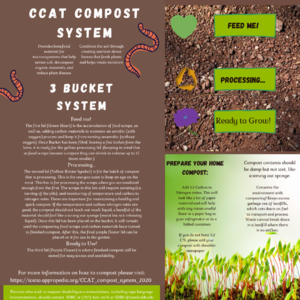
Composting 101 Educational Pamphlet: https://www.appropedia.org/images/6/66/Composting_101_Education_Pamphlet_for_CCAT.pdf
Conclusion[edit | edit source]
Lessons learned[edit | edit source]
We learned that there are a lot of variables to consider for the CCAT composting system. There have multiple previous iterations of a composting system at CCAT that have all ultimately been unsuccessful and so we were very motivated to create a final, long-term, viable composting system for CCAT. There are a lot of people who have access to the composting system at CCAT including volunteers, community members, and people dropping off their food scraps to be composted. These are additional factors that complicate the final compost system we deliver. We realized that clear signage and educational materials are needed to guide the many people working with the CCAT composting system.
Next steps[edit | edit source]
As we go into the future, the next steps for our project are to construct and implement at The Community Center for Appropriate Technology (CCAT). We also will continue our satellite projects to supplement the CCAT system for people to reference for at-home composting options.
Troubleshooting[edit | edit source]
If your compost system is having difficulties, check out this diagnostic to help get finished compost from your system:
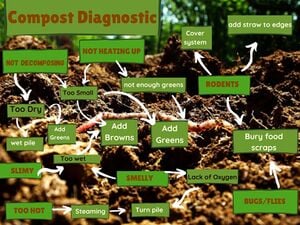
For basic information on composting, click the following link:
Satellite Projects[edit | edit source]
The team made the following satellite projects to bolster the educational value during a shelter in place orders of the way back in 2020, remember those days...:
- Lorelei at home composting with kids
- Kelsey 3-lid 5-gallon bucket design
- Sara June 2 bay pallet system
- Hannah Stacked bin system
Team[edit | edit source]
References[edit | edit source]
